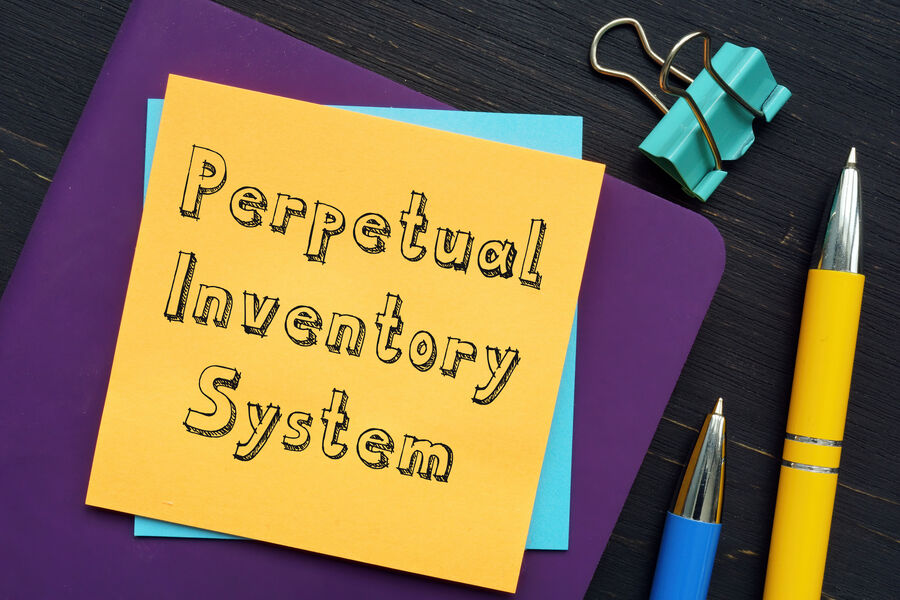
Perpetual inventory systems record transactions—like inventory purchases, sales, returns, and adjustments—as they occur. This is unlike periodic inventory systems, which depend on physical inventory counts and end-of-period adjustments Perpetual inventory systems also provide up-to-date inventory data at any given moment and enhance accuracy, making it a useful tool for manufacturers, retailers, and ecommerce businesses.
- Initial inventory is counted: The perpetual inventory system kicks off with a physical inventory count, which is a manual process where you or your staff physically count every single item in stock. This establishes a starting point for the system’s database, ensuring accuracy.
- Cost of inventory is recorded when purchased: Whenever you purchase and receive new stock from a supplier, the system will update the cost and quantity for that specific item. This usually involves recording the vendor invoice information that contains both cost and quantity information. Some advanced systems might allow you to scan a barcode on the received items and match that to the quantity shown on the vendor invoice.
- COGS is recorded when inventory is sold: When you sell an item, the system deducts the sold quantity from the inventory, reflecting the decreased stock level. It also automatically calculates the cost of the sold inventory using your elected method—generally average cost (AVCO) method or first-in first-out (FIFO) method—and removes that cost from inventory and places it as an expense on the profit and loss statement.
- Perpetual inventory system is integrated with inventory management software: Perpetual inventory systems typically rely on software like point-of-sale (POS) systems or warehouse management systems (WMS) to automate data entry and streamline the process. These software systems work seamlessly with hardware like barcode scanners or RFID radio frequency identification readers.
- Reports are generated to provide analysis: A perpetual inventory system doesn’t just track inventory; it can also generate valuable reports. These reports can provide insights into sales trends so that you can identify which items are selling quickly and which are slow-moving. You can also set minimum reorder levels based on historical sales data and lead times from suppliers and analyze how quickly your inventory is selling and being replaced.
- Actual inventory is compared to reports (optional): Most retailers will occasionally take a physical inventory count to compare the actual quantity on hand to what the perpetual inventory system reports. The difference is usually inventory shrinkage, like theft and breakage, but can also be a sign of a problem with the perpetual system.
When Is a Perpetual Inventory System Used?
Perpetual inventory systems are typically used by businesses that:
- Have high-value or fast-moving inventory: For businesses selling expensive items or products that sell quickly, a perpetual inventory system is a good fit because it will help to ensure that you always have enough stock to meet customer demand.
- Have complex supply chains: Companies with intricate supply chains involving multiple warehouses, distributors, or a large number of products could benefit from the detailed tracking capabilities of a perpetual inventory system.
- Need for real-time data: Businesses that require constant monitoring of inventory levels, like those with seasonal fluctuations in demand or perishable goods, will find perpetual inventory systems beneficial.
- Have high sales volumes: Businesses with a large number of daily transactions benefit from the automated data entry and real-time updates offered by perpetual inventory systems. This helps streamline inventory management and reduce manual work.
Perpetual inventory systems aren’t just for large companies. QuickBooks, Zoho Books, and Xero are all affordable bookkeeping software that incorporate perpetual inventory accounting. Check out our guide to the best retail accounting software for more information.
Here are some specific examples of businesses that commonly use perpetual inventory systems:
- Retail stores: From grocery stores and clothing retailers to electronic shops, perpetual inventory systems help track inventory across multiple locations and ensure they have the right products in stock.
- Manufacturing companies: Manufacturers can track raw materials, work-in-progress goods, and finished products, allowing for better production planning and cost control.
- Ecommerce businesses: Online retailers rely on perpetual inventory systems to manage inventory across warehouses and fulfillment centers, ensuring smooth order fulfillment.
- Wholesale distributors: Wholesalers dealing with a high volume and variety of products can leverage perpetual inventory systems for efficient inventory control and order fulfillment.
Highlights & Challenges of a Perpetual Inventory System
There are many benefits associated with a perpetual inventory system, including the ability to view stock in real time and improved financial accuracy. It offers several advantages over more traditional periodic systems that rely on physical stock counts.
- Real-time inventory tracking: This is one of the core strengths of a perpetual inventory system because it provides continuous, real-time updates on inventory levels so that you know what you have on hand at any given moment. This reduces errors associated with manual inventory counts and periodic updates, leading to more accurate inventory records.
- Reduced stockouts and overstocking: With real-time data, you can identify trends and prevent stockouts by reordering items before they run out. You can also avoid overstocking by being able to recognize slow-moving products and adjust your purchasing strategy.
- Improved efficiency: Perpetual inventory systems automate many inventory management tasks, reducing the need for data entry and physical counts. This facilitates quicker and more informed decision-making by providing more immediate access to inventory data.
- Enhanced financial accuracy: By continuously updating the COGS with each transaction, a perpetual inventory system ensures that financial statements reflect true inventory costs. This improves the accuracy of financial reports by integrating the most up-to-date inventory data with the corresponding accounting system.
- Comprehensive reporting and analytics: A perpetual inventory system allows you to generate comprehensive reports on inventory turnover, sales trends, and stock levels. This aids in analyzing performance and strategic planning. It also provides valuable insights into inventory management practices, helping to identify opportunities for improvement.
- Better customer service: By having the right inventory on hand, you can minimize stockouts and fulfill customer orders more efficiently, which leads to higher customer satisfaction.
While perpetual inventory systems offer significant advantages for businesses that can manage the implementation costs and ensure the accuracy of data, they also come with challenges that include higher upfront and ongoing costs and the complexity of the software.
- Steep implementation costs: It can be expensive to set up a perpetual inventory system because it often requires an investment in software and hardware and potentially hiring additional staff for training and system maintenance. Each item (and variety of that item) must be individually set up and tracked in the software. Staff must carefully input vendor bills while separating the cost and quantity of each different item of inventory.
- Possible data inaccuracy: A perpetual inventory system is only as good as the data it receives. Inaccurate data entry, human error during scanning, and software glitches can lead to discrepancies between the system’s record and actual inventory levels.
- Dependence on technology: Perpetual inventory systems rely heavily on technology to function. System downtime, malfunctioning equipment, and even power outages can disrupt inventory tracking and cause operational issues.
- Difficulty integrating with existing systems: Integrating a perpetual inventory system with existing ERP or accounting software may be complex and require custom development.
Perpetual Inventory System Journal Entries
Happy Camper, a retail store that sells goods for hiking and camping enthusiasts, uses the FIFO method of costing inventory. On December 31, 2022, it reported a merchandise inventory of $35,960 on its balance sheet. The details of the merchandise inventory account are reflected in the inventory quantity report dated January 1, 2023:
Recording Cash Purchases
On January 3, Happy Camper purchased 2,500 units of clothing from a new supplier, Hit the Pavement, for $20 per unit. In the perpetual inventory system, purchases are directly recorded in the inventory account, which appears on the balance sheet. Thus, the purchase has no effect on net income.
Recording Sales on Account
On March 15, Happy Camper sold 2,000 units of clothing at $35 each to ERA, a reseller in New York. A perpetual inventory system generates two journal entries when there is a sale. The first entry records the Sales revenue.
The second entry records the cost of the inventory sold. In our example, assume the cost of the 2,000 units using a FIFO calculation is $40,000. That amount is taken out of inventory and placed on the profit and loss statement as COGS.
Recording Cash Sales
On June 22, Happy Camper sold 1,600 units of clothing at $39 each. These are all cash sales, and the total COGS under the FIFO method is $32,000.
In the perpetual inventory system, the COGS is recorded at the same time as the sale is recorded. This entry must be made every time a sale occurs, which is why the perpetual inventory system should only be used with accounting software that will make the necessary calculations. See our roundup of the best inventory management software for SMBs for options.
Recording Purchases on Account
On April 5, Happy Camper purchased 2,200 units of clothing at $20 per unit from What About Her on account with 30-day terms. This transaction would be recorded as follows:
New COGS and Inventory
In a perpetual inventory system, the COGS account is updated with every transaction, so there is no adjusting journal entry at the end of the period. The COGS and Inventory under the perpetual method are determined by the journal entries already made.
Frequently Asked Questions (FAQs)
While a perpetual inventory system doesn’t directly reduce storage costs, it can lead to better management of inventory and a reduced need for storage. Because a perpetual inventory system tracks inventory in real-time, it allows you to identify when you have too much of something and avoid excess inventory that just sits in storage, taking up space and tying up capital. With accurate inventory data, you can order the right amount of product.
One disadvantage of the perpetual inventory system is its potentially high implementation and maintenance costs, especially compared to a periodic inventory system. Implementation could require a significant investment in hardware and software and possibly new technology for inventory tracking, such as barcode scanners. The system also requires regular maintenance and updates to ensure it functions correctly.
A perpetual inventory system constantly updates inventory records for each transaction, which provides a real-time picture of what you have on hand. After creating a database of all inventory items and implementing technology like barcode scanners, the system will continuously monitor inventory levels, providing up-to-date information on stock quantities and values as inventory is purchased, sold, or returned.
A perpetual inventory system provides a running record of inventory on hand and the COGS after each sale or purchase, while a periodic inventory system uses physical counts of inventory that occur at regular intervals of time such as monthly or quarterly. This enables you to determine how many goods remain in inventory and how many goods have been sold. Unlike a perpetual inventory system, it doesn’t provide daily data regarding inventory levels. Our perpetual vs periodic inventory systems comparison guide provides more information.
Bottom Line
Perpetual inventory systems offer a powerful tool for businesses seeking to streamline operations and gain a competitive edge. By providing real-time data and automating tasks, these systems can significantly improve inventory accuracy, reduce stockouts and overstocking, and boost profitability. However, it’s important to remember that perpetual inventory systems are not a one-size-fits-all solution, so you should consider your business needs, budget, and technical capabilities before implementing one.




